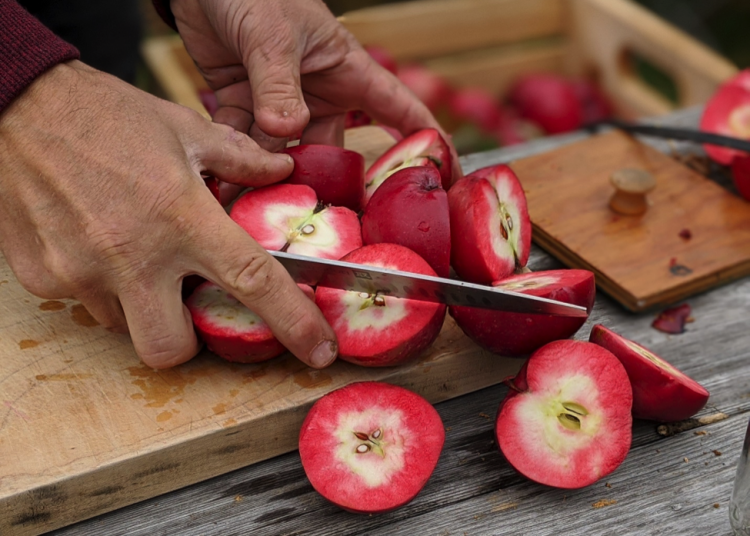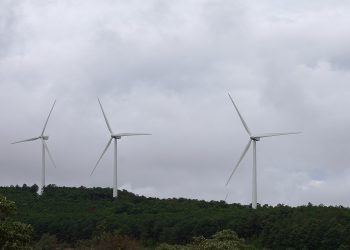This fall, I had the pleasure of pressing apple cider for the very first time with the Mathis family in Durham Bridge. Anna and Andrew and their two children Gibson and Juniper live on a small homestead on Abernethy Road.
They have a passion for making preserves, including homemade juices, wines and ciders. They use some phenomenal ingredients for their preserves, including hawthorn berries, highbush cranberry, chokecherry and elderflowers. They have made wine from tomatoes, elderberries, mint, basil (in the works now) and they will soon start their first pumpkin wine. This year Anna even dried and ground apple peels as a source of pectin to thicken their preserves. These ingredients mostly come from their property or from friends.
They were fortunate to also have been able to get our apples locally at an orchard now owned by the McAvity family on the Red Rock Road, near Stanley, N.B. This orchard was first owned by the MacNaughton family and is believed to be the second oldest registered in New Brunswick, having perhaps eight acres of trees that are no longer in commercial production.
New Brunswick is full of these gems, old orchards containing varieties of apples that may be almost gone from modern cultivation. We found one tree that we believe to be Wolf River apples, each one being roughly the size of a softball. These are common baking apples in this part of the world and added some nice tart flavour to our cider.

There are several different ways to press cider. In this case we had two pieces of equipment, a “chute,” which is a motorized grinder and the press itself. The chute had clearly been made in a home shop for that purpose. A motor turned a grinder wheel inside of a wooden box. We put the apples into the chute and pressed down with a wooden lid of sorts which acted as a safety guide. The end results came out in a bucket at the bottom and is what we generally call pomace. This is a mash which contains core, peel, seeds and all! We then take that to the press.
The press has a cast iron bottom which is a juice collecting plate. There is a barrel that is mounted on top that is assembled in two pieces. A straining cloth is arranged inside of the barrel to keep seeds and pulp out of the juice. The straining cloth could be nylon screen or fabric.

After the pomace is dumped into the straining cloth inside of the barrel, a series of wooden blocks are added. The first set of blocks spread the pressure evenly over the top of the pressing cloth, and the others are spacers so that as the rachet moves downwards, the handle stays clear of the top of the barrel part of the press. The press is placed on top of the blocks and is tightened down like a screw by a long ratchet lever, providing mechanical advantage. As the press puts pressure on the pomace the juice runs out of the collecting plate and into a bucket below.
Apple cider is the raw form of the juice and has a cloudy, orange/yellow look to it. The wild yeasts and bacteria that were on the apples may be present in the juice, this helps with fermentation that turns it into hard cider and eventually apple cider vinegar, after bacteria consume all of the available sugars.
Apple “juice” is filtered to take out any solids, leaving it clear and a deep yellow colour. Apple juice may also be pasteurized to kill bacteria, which some people recommend when giving it to young children. Pasteurizing will also allow the cider to keep longer if canned. Some of the cider that we made will be drank fresh, but most of it will go into the freezer. We love to have a nice taste of Summer and Autumn in the middle of February.

As we always do and our friend group, we took some time to sample people’s preserves and have a small potluck. As we chatted, I learned the origin of the cider of pressing tradition. Anna and Andrew started dating when they were in high school. Andrew’s family are longtime friends with the Whitney family, who at that time lived just outside of Sussex. One fall, on a visit to the Whitney’s Homestead they made apple cider. It was such a lovely experience that it has become a yearly tradition. A few years ago, the Whitney’s moved to Fredericton, so the tradition has now moved to the Mathis’ homestead in Durham Bridge.
The Whitney family themselves were homesteaders, moving from Toronto to the Kennebecasis Valley in the 1970s. I’m currently reading a book written by Lee about those very experiences called, Knowing By Heart: A Tribute to a Kennebecasis Valley Homestead Farm (Chapel Street Editions).
As I read the accounts of this family’s homesteading experience in the 1970s, I think about the current wave of new homesteaders and how critical the passing on of intergenerational knowledge is. The folks that were homesteading in the 1970s had the opportunity to learn from older folks, who would have lived their early days in a “pre-modern” world.
At that point in time, someone in their 80s would have been born around 1890. The knowledge they received, particularly around things like hand tools, preserving food and doing on-farm repairs would have been invaluable. Without those conversations and walks through the farm, that information would have probably been lost forever.
It was suggested to me a few weeks ago that there are so many people in their 60s and 70s with a wealth of knowledge around homesteading and small farms that don’t have anyone to teach. Perhaps, it is time for an intergenerational mentorship program?
Come to think of it, we were doing more than pressing for juice, we were pressing for knowledge and the preservation of heritage. Gibson will be three soon, and he moved about the property freely as we did our work. Juniper was born in July, and accompanied Mom in a sling while she worked. This makes me quite hopeful that the knowledge is getting passed along in the most subtle and enjoyable of ways.
If you have ideas about multi-generational mentorship, I would love to hear from you. You can also send me your favourite preserving recipes and stories about your fondest memories of gardening and putting away food. Some community members are interested in putting together a traditional, local food cookbook and your contributions could help.
This winter I will be working on a Local Food Action Plan for the upper Nashwaak Valley with a group of mixed stakeholders, who want to increase food security. You can reach me at amypfloyd@gmail.com with your comments and suggestions.
Amy Floyd is the Senior Food Security Policy Analyst with the Raven Project (Rural Action and Voices for the Environment). Amy also runs the Permaculture Atlantic Network and keeps a large home garden in Taymouth.









![Is pollution from industry causing the neurological disease ALS in New Brunswick? [video]](https://nbmediacoop.org/wp-content/uploads/2025/10/Quintin-Soloviev-Belledune_Generating_Station_in_New_Brunswick_Canada-120x86.jpg)
